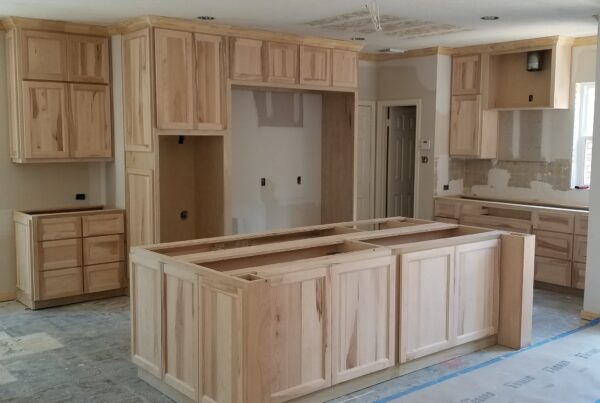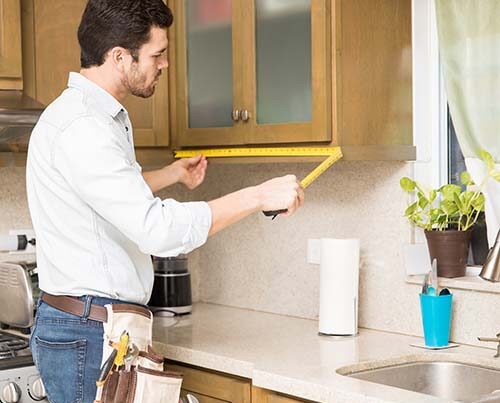Ever wondered why the same wood stain looks different on various types of wood? Well, it’s all about the unique characteristics of each wood species. Understanding how different woods interact with stains helps you make the best choice for your desired finish for your custom cabinets.
1. Absorption: It’s All in the Pores
The way wood absorbs stain depends on its porosity. Woods like oak have large pores, which means they absorb more stain and show a more pronounced color change. On the other hand, dense woods like maple have tighter grain, resulting in a more subtle stain effect. So, the porosity of your wood will greatly influence the intensity of the stain.
2. Natural Color: The Underlying Hue
Remember, wood isn’t a blank canvas. Each species has its inherent color, which will mix with the stain’s color. For instance, applying a light stain on red oak will still retain a reddish undertone. Understanding the natural color of your wood can help you anticipate the final outcome.
3. Grain Pattern: Highlighting Nature’s Design
Stain not only changes the color of wood but also accentuates its grain pattern. Woods with an open grain, like ash, will have a more dramatic grain appearance after staining, while those with a fine grain, like birch, will have a more even-toned finish. Choose a stain that complements the wood’s natural grain.
4. Testing: The Key to Perfection
Here’s a pro tip: always have your cabinet maker test your stain on a scrap piece of wood. This will give you a realistic preview of the final result and save you from potential surprises.
Final Thoughts
The interaction between wood species and wood stain is a beautiful dance of color and texture. Knowing how different woods react to stains can help you achieve the desired finish in your custom cabinet projects. So, next time you pick a stain for your custom kitchen cabinets (for example), consider the wood’s porosity, natural color, and grain pattern.
Anonimski, CC0, via Wikimedia Commons
Red Oak
Red oak, often just called oak, is known for its light to medium brown color with reddish tinges, along with a distinct, mostly straight grain pattern.
What makes red oak appealing is its versatility. It looks great with a clear finish or a dark stain. Although not common, red oak can also be painted, giving a unique texture that’s rare in other painted cabinets.
Often seen as a traditional cabinet wood, oak can be styled in modern ways too.
As for cost, oak is usually in the same price bracket as maple and birch, though its price can vary.
Red Oak Characteristics
Color: Light to medium brown with a reddish or golden hue
Grain Pattern: Strong and distinctive, usually straight with some waves
Grain Contrast: High, with prominent patterns
Hardness: 1290 Janka, (hard)
Stain Reception: Excellent, brings out the grain patterns well
Sustainability: Mostly sustainable, particularly from managed forests
Cost: Generally average
White Oak
Red oak, often just called oak, is known for its light to medium brown color with reddish tinges, along with a distinct, mostly straight grain pattern.
What makes red oak appealing is its versatility. It looks great with a clear finish or a dark stain. Although not common, red oak can also be painted, giving a unique texture that’s rare in other painted cabinets.
Often seen as a traditional cabinet wood, oak can be styled in modern ways too.
As for cost, oak is usually in the same price bracket as maple and birch, though its price can vary.
White Oak Characteristics
Color: Light to medium brown, with a reddish or golden hue
Grain Pattern: Strong and distinctive, typically straight with some waves
Grain Contrast: High, with clearly visible patterns
Hardness: 1360 Janka (hard)
Stain Reception: Excellent, ideal for emphasizing grain patterns
Sustainability: Mostly sustainable, particularly from responsibly managed forests
Cost: Generally average
Maple
Maple, a classic Canadian hardwood, is a top choice for kitchen cabinets. It’s quite similar to birch, with a smooth surface and comparable grain pattern. The grain of maple is typically straight, occasionally showing subtle waves and curls. Its color ranges from soft white to reddish-brown.
Like birch, maple’s physical traits make it suitable for painting. But unlike birch, maple is less porous, so there’s less chance of blotchiness when staining, especially with darker colors. Maple is also reasonably priced, making it an accessible option in North America. It’s in the same price range as birch and oak, depending on where you buy it.
Maple Characteristics
Color: Creamy white to light reddish-brown
Undertone: Generally uniform, may yellow slightly with age
Grain Pattern: Generally straight, but can be wavy or curly
Grain Contrast: Low to moderate
Hardness: Hard Maple – 1450 Janka (Very Hard); Soft Maple – 950 Janka (Moderately Hard)
Stain Reception: Can be blotchy, requires pre-stain conditioning for even application
Sustainability: Usually sustainable, widely grown
Cost: Average to High
Cherry
Cherry wood is known for its rich, dark, reddish-brown color and smooth grain, making it a luxurious choice for kitchen cabinets. Cherry naturally changes color over time, starting light or golden pink and deepening to a reddish-brown. This aging process means cherry often doesn’t need a deep stain like other woods.
Most people choose a clear coat finish for cherry to showcase its natural color and grain. As one of the more elegant woods, cherry is priced higher, usually below walnut and rift-cut white oak, but above common woods like maple and red oak.
Cherry Characteristics
Color: Rich reddish-brown
Undertone: Darkens to a deeper red over time
Grain Pattern: Straight and fine
Grain Contrast: Moderate
Hardness: 950 Janka (Moderately Hard)
Stain Reception: Stains well, but often preferred with only a clear finish to showcase natural color
Sustainability: Varied; sustainability depends on sourcing
Cost: High
Birch
Birchwood is pale, often with a slight yellow tint. It has a straightforward and mostly straight grain. As it ages, it turns a yellowish-red color. Birch is great for painting because of its subtle grain and even surface. It’s a top choice for painted wood cabinets. One thing to note is that birch is a bit porous. This means when staining, especially with dark colors, it can absorb unevenly and look blotchy. Dark stains might also unevenly highlight parts of the grain.
Birch Characteristics
Color: Light yellow to creamy white
Undertone: Subtle grain, may appear slightly yellow or reddish
Grain Pattern: Straight or slightly wavy, fine grain
Grain Contrast: Low to moderate, with a mostly uniform appearance
Hardness: Yellow Birch – 1260 Janka (Hard)
Stain Reception: Can be blotchy, often requires pre-stain conditioning
Sustainability: Generally sustainable
Cost: Average
Walnut
Walnut is a striking wood known for its color variation from light to deep dark brown and its strong, usually straight grain. Its grain is open and a bit coarser than cherry, but walnut still offers a uniform surface. Over time, walnut’s dark brown color naturally lightens, giving it a unique aging process.
Walnut works well with light stains and clear coat finishes. A clear top coat on walnut brings out a rich, velvety sheen that highlights its bold grain pattern. As walnut isn’t as common as woods like maple or oak, it’s more expensive. Its price is higher than cherry, comparable to rift-cut white oak.
Walnut Characteristics
Color: Rich, dark brown
Undertone: Warm and chocolatey, occasionally with purplish hues
Grain Pattern: Mostly straight, can have waves or curls
Grain Contrast: Moderate to high, with a rich, luxurious look
Hardness: 1010 Janka (Moderately Hard)
Stain Reception: Stains well, though often used with natural finish to preserve its color
Sustainability: Can be sustainable, but slower growth rate affects availability
Cost: Very High
Rustic Alder
Rustic Alder is one of the softer hardwoods and is known for its rustic charm. It has a light base color with yellow to peach tones and is full of large knots. The number and appearance of knots vary, giving each piece a unique look that’s perfect for rustic or farmhouse-style kitchens.
The soft nature of alder means it naturally develops a distressed look over time, with dents and scratches adding to its appeal. In fact, these ‘imperfections’ are often seen as desirable features in rustic alder.
While it can take darker stains, rustic alder is often appreciated for its natural look. Traditional glazes are a popular finish as they enhance its rustic qualities. Rustic alder is a premium hardwood, priced similarly to cherry, just below the cost of walnut and white oak.
Rustic Alder Characteristics
Color: Light brown with a reddish tinge
Undertone: Consistent color, similar to Cherry but softer
Grain Pattern: Straight and even, with a fine uniform texture
Grain Contrast: Low, with a uniformly smooth appearance
Hardness: 590 Janka (Soft)
Stain Reception: Stains evenly, good for achieving a uniform finish
Sustainability: Generally sustainable
Cost: Average
Pine
Color: Pale yellow to light brown
Undertone: Knots and streaks add character, can yellow with age
Grain Pattern: Straight or slightly wavy with prominent knots
Grain Contrast: High, especially around knots and in rustic grades
Hardness: Eastern White Pine – 380 Janka (Very Soft); Yellow Pine – 690 to 870 Janka (Soft to Moderately Hard)
Stain Reception: Absorbs stain unevenly, prone to blotching, often requires a conditioner
Sustainability: Generally sustainable, especially in North America
Cost: Low
Mahogany
Color: Medium to dark reddish-brown
Undertone: Deep, warm red tones
Grain Pattern: Straight to interlocked, with a medium to coarse texture
Grain Contrast: Moderate to high, depending on the cut and figure
Hardness: Genuine Mahogany – 800 Janka (Moderately Hard)
Stain Reception: Stains evenly, enhancing its natural elegance
Sustainability: Can be sustainable, but some species are endangered
Cost: Very High
Hickory
Color: Light to dark brown, often with contrasting streaks
Undertone: Wide variation in color, from nearly white to dark brown
Grain Pattern: Straight, coarse texture with significant color variation
Grain Contrast: Very high, with distinct light and dark areas
Hardness: 1820 Janka (Very Hard)
Stain Reception: Accepts stain well but can amplify color variations
Sustainability: Generally sustainable
Cost: High
Ash
Color: Light to medium brown
Undertone: Pale and neutral
Grain Pattern: Bold, straight grain with occasional waves
Grain Contrast: High
Hardness: White Ash – 1320 Janka (Hard)
Stain Reception: Accepts stain well, enhancing the grain contrast
Sustainability: Threatened by the emerald ash borer in some areas
Cost: Average









